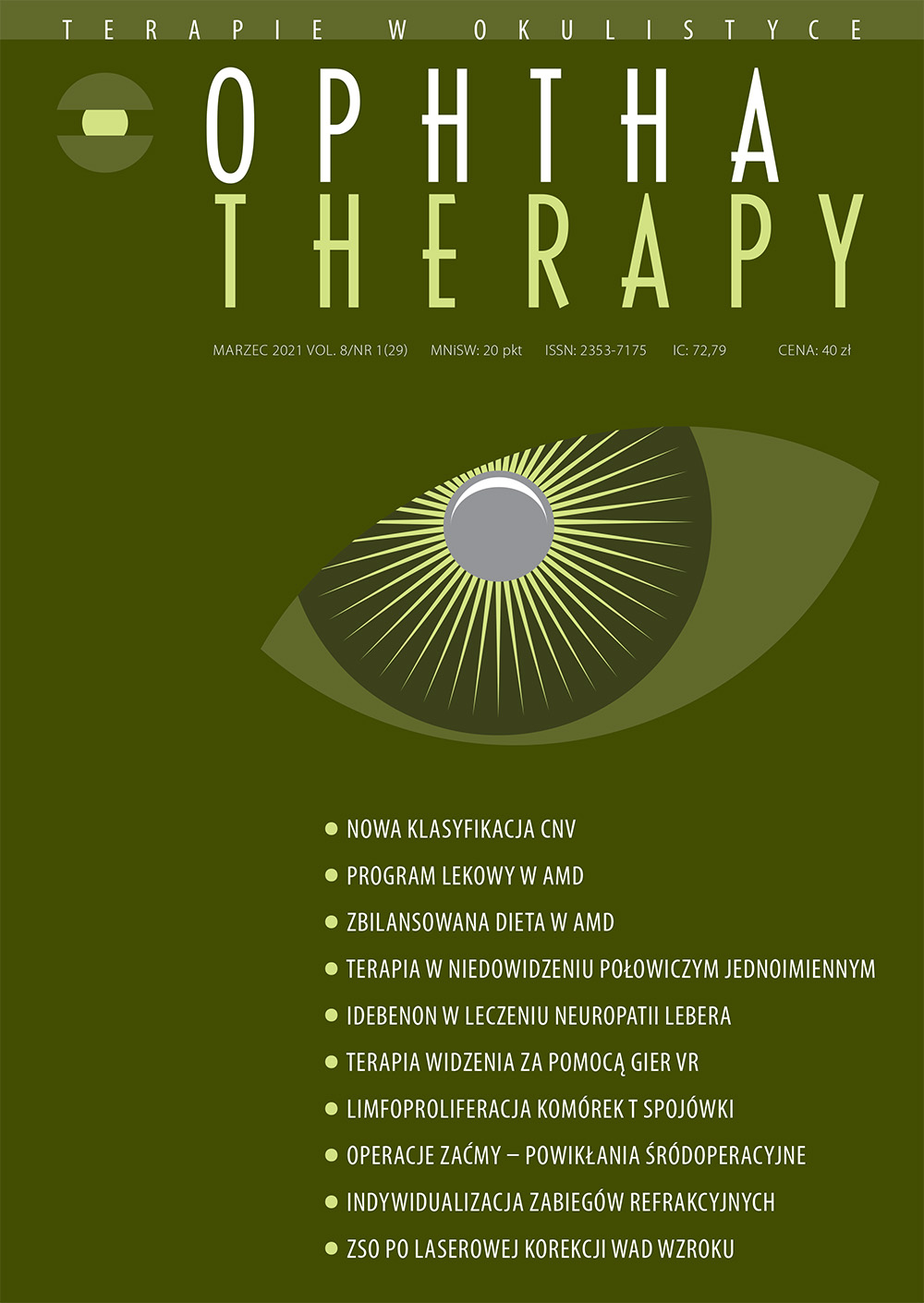Individualizing approach to management of refractive errors Review article
Main Article Content
Abstract
The proper choice of the method of refractive error correction is essential for both achieving optimal results and patient satisfaction. This selection should be based on the results of a detailed pre-examination, patient expectationsand the refractive surgeon’s personal experience. The article presents the main criteria for selecting the most commonly used corneal and intraocular methods for the correction of all refractive errors.
Downloads
Article Details

This work is licensed under a Creative Commons Attribution-NonCommercial-NoDerivatives 4.0 International License.
Copyright: © Medical Education sp. z o.o. License allowing third parties to copy and redistribute the material in any medium or format and to remix, transform, and build upon the material, provided the original work is properly cited and states its license.
Address reprint requests to: Medical Education, Marcin Kuźma (marcin.kuzma@mededu.pl)
References
2. Jones C. Refractive Surgery. Market Report. MarketScope. 2019; 2020: 1-283.
3. Montés-Micó R, Rodríguez-Galietero A, Alió JL. Femtosecond laser versus mechanical keratome LASIK for myopia. Ophthalmology. 2007; 114: 62-8.
4. Moshirfar M, McCaughey MV, Reinstein DZ et al. Small-incision lenticule extraction. J Cataract Refract Surg. 2015; 41: 652-65.
5. Ozulken K, Yuksel E, Tekin K et al. Comparison of Wavefront-Optimized Ablation and Topography-Guided Contoura Ablation with LYRA Protocol in LASIK. J Refract Surg. 2019; 35: 222-9.
6. Reinstein DZ, Couch DG, Archer TJ. LASIK for hyperopic astigmatism and presbyopia using micro-monovision with the Carl Zeiss Meditec MEL 80. J Refract Surg. 2009; 25: 37-58.
7. Coskunseven E, Jankov MR, Hafezi F et al. Effect of treatment sequence in combined intrastromal corneal rings and corneal collagen crosslinking for keratoconus. J Cataract Refract Surg. 2009; 35: 2084-91.
8. Yoo A, Kim JY, Kim MJ et al. Hydrogel Inlay for Presbyopia: Objective and Subjective Visual Outcomes. J Refract Surg. 2015; 31: 454-60.
9. Whitman J, Hovanesian J, Steinert RF et al. Through-focus performance with a corneal shape-changing inlay: One-year results. J Cataract Refract Surg. 2016; 42: 965-71.
10. Packer M. Meta-analysis and review: effectiveness, safety, and central port design of the intraocular collamer lens. Clin Ophthalmol. 2016; 10: 1059-77.
11. Rosen E, Alió JL, Dick HB et al. Efficacy and safety of multifocal intraocular lenses following cataract and refractive lens exchange: Metaanalysis of peer-reviewed publications. J Cataract Refract Surg. 2016; 42: 310-28.
12. Randleman JB, Woodward M, Lynn MJ et al. Risk assessment for ectasia after corneal refractive surgery. Ophthalmology. 2008; 115: 37-50.
13. Santiago MR. Percent tissue altered and corneal ectasia. Curr Opin Ophthalmol. 2016; 27: 311-5.
14. Hecht I, Achiron A, Ben Haim L et al. Refractive surgery in the late adulthood and adolescent age groups. Graefes Arch Clin Exp Ophthalmol. 2019; 257: 2057-63.
15. Zhang ZH, Jin HY, Suo Y et al. Femtosecond laser versus mechanical microkeratome laser in situ keratomileusis for myopia: Meta-analysis of randomized controlled trials. J Cataract Refract Surg. 2011; 37(12): 2151-9.
16. Vega-Estrada A, Alió JL, Arba Mosquera S et al. Corneal higher order aberrations after LASIK for high myopia with a fast repetition rate excimer laser, optimized ablation profile, and femtosecond laser-assisted flap. J Refract Surg. 2012; 28: 689-96.
17. Guo H, Hosseini-Moghaddam SM, Hodge W. Corneal biomechanical properties after SMILE versus FLEX, LASIK, LASEK, or PRK: a systematic review and meta-analysis. BMC Ophthalmol. 2019; 19: 167.
18. Wen D, Tu R, Flitcroft I et al. Corneal Surface Ablation Laser Refractive Surgery for the Correction of Myopia: A Network Meta-analysis. J Refract Surg. 2018; 34: 726-35.
19. Zhao LQ, Wei RL, Cheng JW et al. Meta-analysis: clinical outcomes of laser-assisted subepithelial keratectomy and photorefractive keratectomy in myopia. Ophthalmology. 2010; 117: 1912-22.
20. Wu W, Wang Y, Xu L. Epipolis-laser in situ keratomileusis versus photorefractive keratectomy for the correction of myopia: a meta-analysis. Int Ophthalmol. 2015; 35: 757-63.
21. Zhang R, Sun L, Li J et al. Visual and Refractive Outcomes After Sub-Bowman Keratomileusis and Transepithelial Photorefractive Keratectomy for Myopia. Eye Contact Lens. 2019; 45: 132-6.
22. Reinstein DZ, Carp GI, Archer TJ et al. LASIK for the correction of presbyopia in emmetropic patients using aspheric ablation profiles and a micro-monovision protocol with the Carl Zeiss Meditec MEL 80 and VisuMax. J Refract Surg. 2012; 28: 531-41.
23. Laser Vision Correction. Patient Information. The Royal College of Ophthalmologists. Online: http://www.rcophth.ac.uk (access: 1.02.2021).
24. Phakic Intraocular Lens Implantation. Patient Information. The Royal College of Ophthalmologists. Online: http://www.rcophth.ac.uk (access: 1.02.2021).
25. Refractive Lens Exchange. Patient Information. The Royal College of Ophthalmologists. Online: http://www.rcophth.ac.uk (access: 1.02.2021).

